-
Posts
1,832 -
Joined
-
Last visited
Content Type
Profiles
Forums
Store
Help Articles
Posts posted by vengroff
-
-
Very nice, grabbed my copy a moment ago. How about adding some vegetables? I sous vide potatoes and turnips at least as often as I sous vide meat.
Great idea. 3.0 was more about functionality, but 3.1 will be a mix of functionality and more foods, veggies included.
-
Happy Valentine's Day! 3.0 is finally in the app store. Please upgrade and enjoy.
-
LOL! I would NEVER have thought I should put the tape on the bag and then poke through it! Thanks, pep and Paul!
Also, note that you really need a needle probe. Here is an example. Needle probes are normally sold as a non-standard accessory for type K thermometers. A standard thickness meat thermometer probe will be more prone to leakage, even with the proper tape.
-
Dave Arnold tackled the topic of spherical ice vs. crushed ice vs. other shapes on Episode 70 of his Cooking Issues radio show.
-
Gum-stabilized bottled salad dressing.
It takes two minutes to whisk a nice vinaigrette together, and you get to choose which combination of oil and vinegar, and what herbs, spices and/or aromatic to use every time. But 99% of home cooks never do it.
-
My kit is here and its already cooking my first batch of chicken thighs!
Would the sv dash cooking time be different with more bags of chicken inside vengroff?
As long as water circulates around each bag the cooking time is the same regardless of the number of bags.
That's true, assuming the water bath temperature remains constant.
Obviously, if you throw six bags of cold chicken in a small pot, the temperature of the bath will decrease, and then it is a question of how quickly the water bath reheats.
A good rule of thumb is that the amount of water should be on the order of six times the volume of the food you are cooking.
I agree with the above. Also, with multiple bags I find it very useful to have some kind of stainless steel rack in the bath to keep good separation between them so the water flows smoothly around all of bags. If you inadvertently create regions with little or no water flow you are going to have a hard time maintaining uniform temperature in the bath.
-
My short answer is that for a 70mm steak 3.5 hours at 58°C is likely to produce decent, but not exceptional results. For really thick steaks, one often has to use water hotter than the final core temperature in order to get to the desired temperature in a reasonable amount of time. This results in uneven final temperatures. The core can be medium rare but the edges can be closer to medium, as in more traditional cooking methods.
In the upcoming SVD 3.0 release, we try to highlight and explain this and other effects as much as possible, rather than simply giving you the big red warning message. The idea is to help people diagnose why the app says certain things, so they can make changes to get the results they want. Here’s a little bit of how it works in this case.
First, let’s start with that 70mm steak in 58°C water, aiming for a core that is a classic 54.4°C medium rare and pasteurizing at the surface. Here’s what we get.
Notice that when the core reaches 54.4 the surface is at 57.6, which is heading more towards medium. There is an orange warning in the cooking journal to alert us to this in case we don’t notice it on the graph. It is also worth noting that we just missed four hours by three minutes, so it's not a major disaster. In fact, we pasteurized the surface much earlier than that.
If we touch the info icon on the warning, it expands, and we get a full explanation of what is going on and why the warning was produced.
Essentially, we are losing some of the magic of sous vide because we are not getting even doneness from edge to edge.
Another thing that greatly affects time to temperature is shape. The steak setting is designed for steaks that are thin enough that the heat which reaches the center comes overwhelmingly from the top and bottom. Once a steak gets really thick relative to its other dimensions, it tends to reach temperature more quickly because more heat from the sides reaches the center. If we change the shape to a medallion, we see this happen.
The overall cooking time is quicker, but we still have different temperature at the surface and the core.
Because temperatures are not the same at the surface and core, the core temperature will actually continue to rise even after we remove the food from the water bath. This can happen even when we drop it directly into an ice bath, as shown here.
The shape of the black core temperature curve looks like a shark fin. If we zoom the graph in a bit we can see this. It is also pointed out in a warning.
Even though the surface temperature begins to plunge immediately after the food hits the ice, we don’t actually reach peak core temperature until the steak has been in the ice bath for almost eight minutes. If the steak were not put in an ice bath, the peak at the core would be even higher and later. Now it is starting to seem more like the behavior you expect from a roast than from sous-vide cooking.
If we drop the desired core temperature to 53 but keep the water at 58, we can get away with something closer to three and a half hours, but then we have even more of a temperature gradient.
The final issue I have with quoting a 3:30 time the way SousVide Pro does is that they quote it for 60-70mm thicknesses. The problem is 60 is very different than 70. Cooking time grows roughly as the square of thickness. Their 10mm ranges and the smaller end, e.g. quoting a time for 20-30mm are even more suspect. 30 is 50% larger than 20, which leads to a time to temperature that is 125% longer. Looking at other apps and tables like this with large ranges is what led me down the path of writing my own code. That code eventually became SVD. Just to illustrate the point further, here are the same settings but for 60mm. Notice the time drops by about 3/4 of an hour.
We can spot check this by squaring the ratio of the thicknesses and seeing if it matches up with the ratio of cooking times. (70/60)^2 = 1.36. And for the times, 216 min./ 162 min. = 1.33. Pretty close, with the difference only due to surface effects.
All of this sums up why I personally tend to stay away from very large cuts done sous vide. I rarely do anything thicker than 30-35mm. Thicker pieces just don’t get you the consistent edge-to-edge results you can get with thinner cuts that you can bring to a constant temperature. The only exception is really long cooks where tenderness is the goal, though even there we have to be careful with size to ensure reasonably rapid pasteurization to the core.
-
-
Also, vengroff, whats the correct equipment to select in sous vide dash for the 1500w fresh meal solutions kit? http://freshmealssolutions.com/store/products/-SVM%7B47%7DFMM-SousVide-Combo-%252d-Free-Int.-Shipping.html
In version 2.1 there is beta support for the SVM/FMM combo.
-
I use a stainless steel rack to keep my bags in one place. This particular model is designed for a SousVide Supreme but it works in a variety of cooking vessels. It's very versatile; you can rotate and use it with bags of a wide variety of thicknesses.
-
As a newcomer to sous vide cooking, I am still on a steep learning curve. However, this app has really helped me. I don't know if this is feasible but in addition to starting food from frozen, it would be nice to know how long to re-heat food. For example, I have beef braising ribs which have been cooked sous vide in the freezer and I have no clue as to how to go about re-heating them. I had cooked sous vide pork chops back when I first got my immersion circulator and then had to guess at how long to put them back into a water bath from a fridge temp to re-heat. The chops were not as good as when I seared them immediately after removing from the hot water bath. Like I said, this might not be feasible and maybe there already are instructions for this somewhere and I haven't found them yet.
In general, it just needs to be in the bath long enough to come to core (serving) temperature, that is assuming it was first cooked sous vide to the desired degreee of doneness and for whatever pasteurization you wanted, then quick chilled without opening. If you had opened the pouch then resealed, you may want to re-pasteurize as well.
ElsieD, mgaretz is correct. From the app's standpoint, reheating is no different than heating to temperature in the first place. One important thing to note in what he said is that you are heating to serving temperature. This may not necessarily be the temperature you cooked at to achieve your desired doneness and pasteurization. It is simply the temperature at which you wish to eat the food.
-
Not to nitpick, but don't some longer cooks, at higher SV temps like 70+ sometimes result in phase change puffing up the bag a little? My briskets almost always have a small bubble in the corner of the bag after 24 hours, but there are no off flavors or odors (of course, I keep the bags weighed down so they remain fully submerged).
If it's quite small, I guess it's probably OK. But it's one more warning sign. Certainly in combination with an odor, I would not eat it.
[Edited typo.]
-
If you're getting a sour flavor, that suggests that you are growing some kind of bacteria in the bag that produces acid. This could be from the spices or it could be from the surface of the meat. Why don't you try thoroughly searing the outside of the meat before bagging it, and don't use any spices. Then cook as normal and see whether you still get the same result. If you don't have the sourness after doing this, that tells you something.
I agree. Another thing to watch for is gas in the bag, which is a sign that bacteria is present. There should be nothing but solid and liquid in the bag, even after long cooking. If there is a bubble of gas at the top of the bag, you'd be well advised not to eat the contents.
-
It would be nice to have the option to start the food temperature at freezer temps in addition to refrigerator temps.
We are exploring this. The simulation gets a little challenging, so it's going to take some work. I have spoken with Douglas Baldwin and other experts and I now understand the problems, but don't have an accurate solution yet.
The basic problem is that while the food is defrosting in the circulator there are three distinct zones each of which has its own unique physics. The outer zone is fully defrosted and starting to cook like food out of the refrigerator. The middle zone contains a slushy mixture of water and small ice crystals. The innermost zone is still fully frozen. Over time the inner and middle zones shrink and eventually disappear. But keeping track of how the boundaries between these zones move over time adds complexity to the model. In time I'm sure we will figure it all out, but it's going to take a while and we'll need some very extensive testing to validate the models.
As a newcomer to sous vide cooking, I am still on a steep learning curve. However, this app has really helped me. I don't know if this is feasible but in addition to starting food from frozen, it would be nice to know how long to re-heat food.
Thank you. You should be able to calculate reheating times using the time-to-temperature mode. This will compute how long it will take the reheat from refrigerator temperature to your desired serving temperature. Just make sure you cooked to pasteurize to the core the first time and cooled in an ice bath before you put the sealed bag into the refrigerator.
-
Congrats on the mention of Sous Vide Dash on the Cooking Issues podcast!
Thanks!
-
I'm sous viding skirt steak at 56c for 9-10 hours. Can I go straight from bag to pan or do I need to put it into an ice bath first for safety reasons?
Straight from bag to pan is fine. 90% of what I sous vide I do that way. Rapid chilling with ice is only needed if you plan to store it in the bag and reheat later.
-
My son is quite excited about version 3.0! I am too...lol...
Love it. Never too young to get started.
-
It's looking great! Now all it needs is the ability to save/print/email the "recipe" so you can remember what you did!
Can you say 3.1?
-
I'm really excited about the new version 3.0 look that we are testing now.
As shown below, there are three big changes:
1. An option to add additional cooking time for tenderness. This is tacked on after the food reaches temperature.
2. An option to cool the food in an ice bath after cooking. This is enabled, and you can see the effect in the graph where the temperature drops when it hits the ice bath.
3. A new display with a summary of key events followed by a detailed time line of every potentially interesting event in the cooking process. This is scrollable so you can see everything that is going to happen. Pathogen details are at the bottom below it (not shown here).
It's going to be a few more weeks before this hits the app store, but I wanted to see if there is any early feedback. I really like this new layout, and am eager to hear if you do as well.
-
Posting this only because I couldn't find any answers and so did the experiment. I wanted to cook some whole small potatoes (1.5-2 inches in diameter)and then quickly saute them in sugar and butter to make Danish potatoes. So I bagged them with a little goose fat and some salt and put them in the S-V at 84C for 2 hours. They are perfectly cooked and ready to be glazed.
Sounds great. I have always done SV potatoes in a large dice, but I will definitely try this.
-
A new version of the app just hit the US app store. It should be available around the world within 24 hours. From the release notes:
This version (2.1) of SousVide Dash is the first that runs on iOS 5 only. Transitioning to iOS 5 enables us to take advantage of some unique new features in upcoming versions of the app. It also increases the reliability of our testing processes.
Most of the users we surveyed told us they are now on iOS 5. We decided to do this transitional release to give the rest of you some time to upgrade.
New features include:
- More equipment supported.
- Twitter integration. Tweet what you are cooking to your followers.
There will be some big additions in the next release, such as support for computing ice bath cooling times, so please take this opportunity to upgrade to iOS 5 so you are ready for the next release.
-
yes but with a steak, we are measuring the thickness on the small side, not how long the steak is.
Correct.
-
That's my understanding. The 'thickness' is the minimum distance from the edge to the centre, as that's what limits how fast heat can get to the centre.
Thickness is edge to edge..not edge to center. I would assume sous vide dash app takes into account heating from all sides.
Yes, you are correct on both counts.
-
The caution regarding garlic in Sous Vide relates to whole garlic cloves where direct contact of the whole clove against the meat can cause localized saturation of the flavor. Thomas Keller in Under Pressures advises to wrap the garlic and other whole herbs in plastic wrap, cut off the ends of the wrap and put them in the bag with the other ingredients.
I use Keller's technique with scraps of plastic from the bag roll. If you look closely you can a diagonal strip of it here protecting the meat from direct exposure to the rosemary and garlic slices.



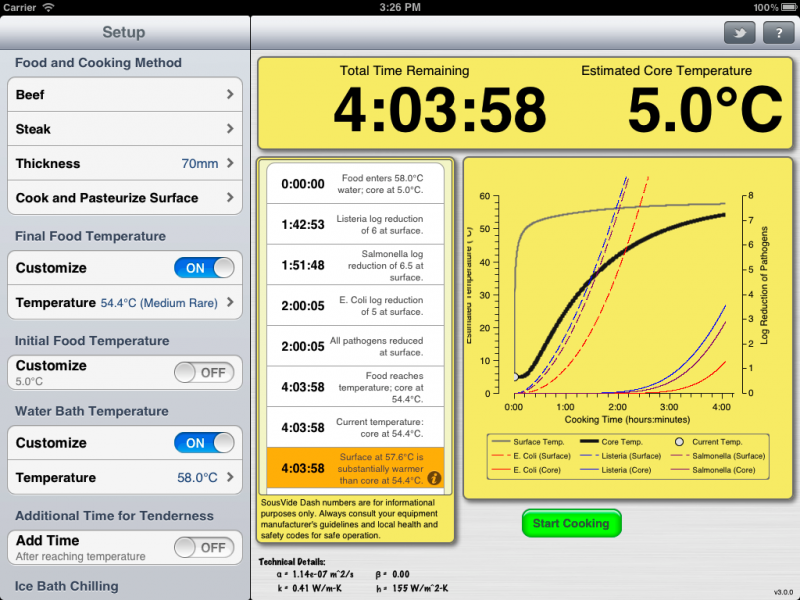

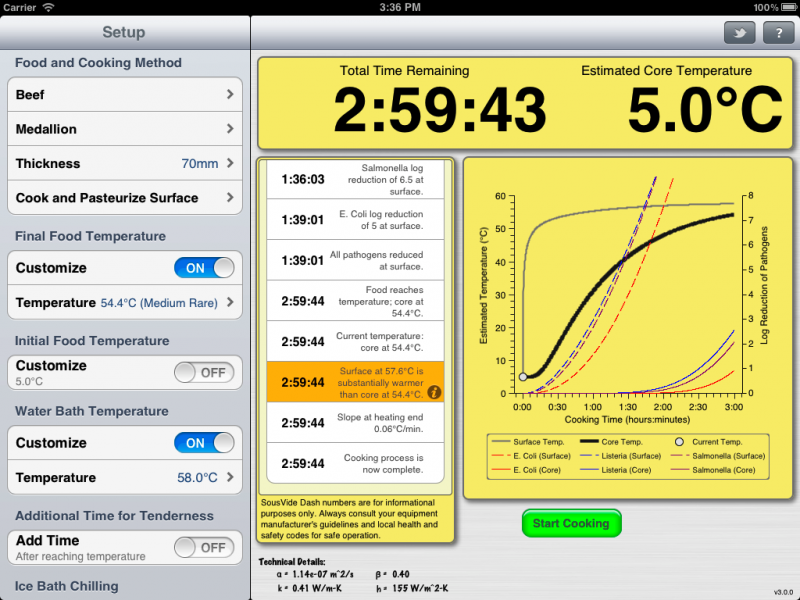
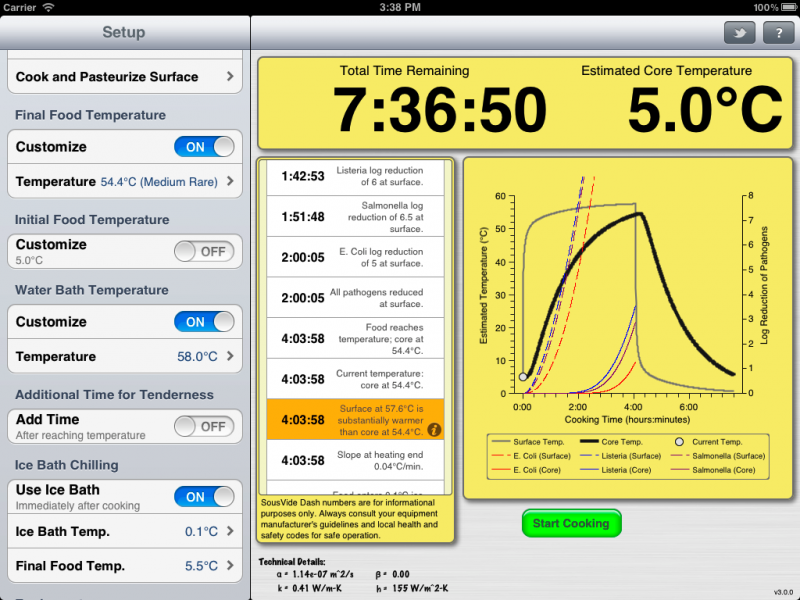
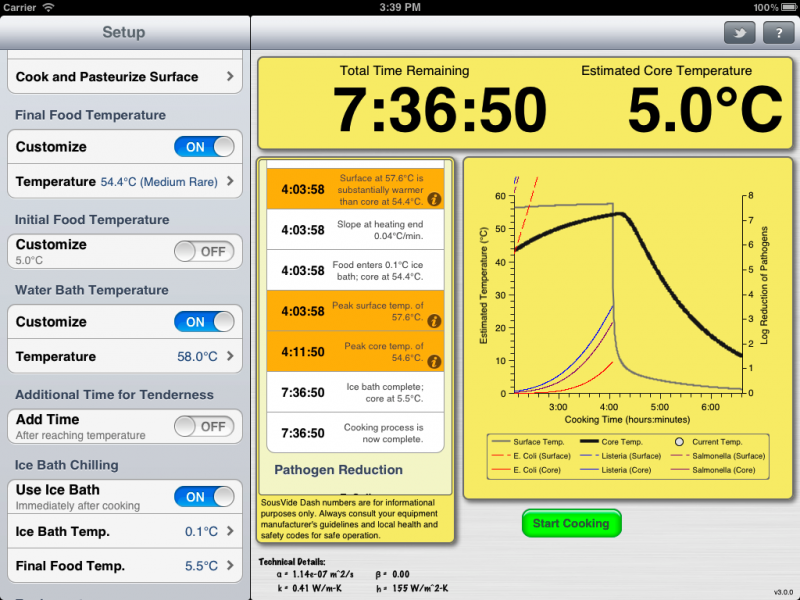
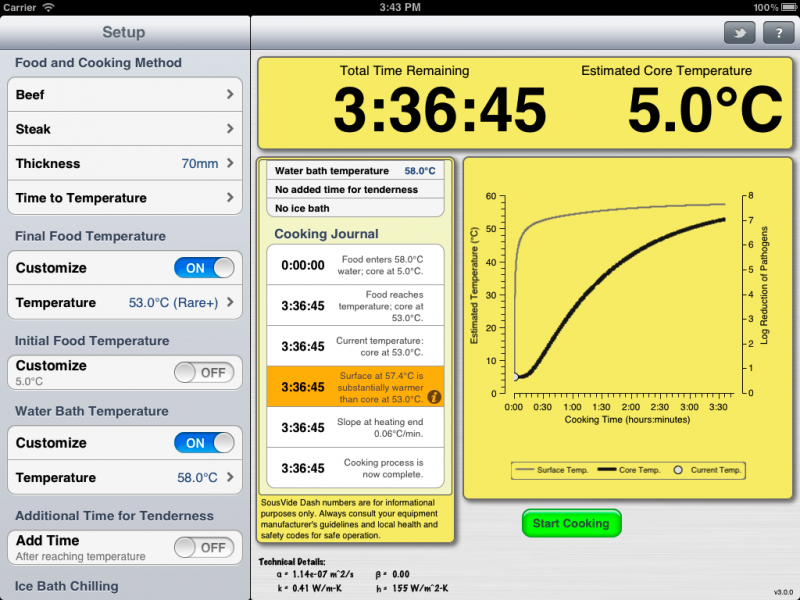
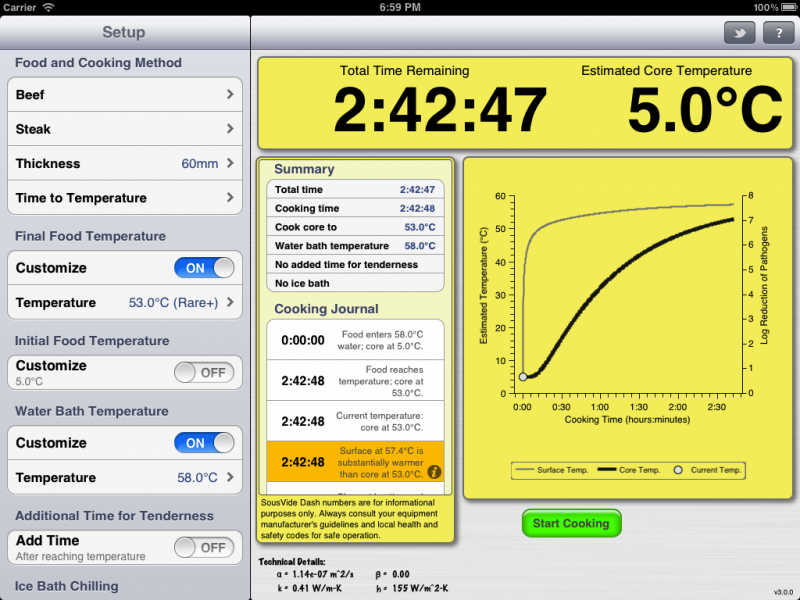

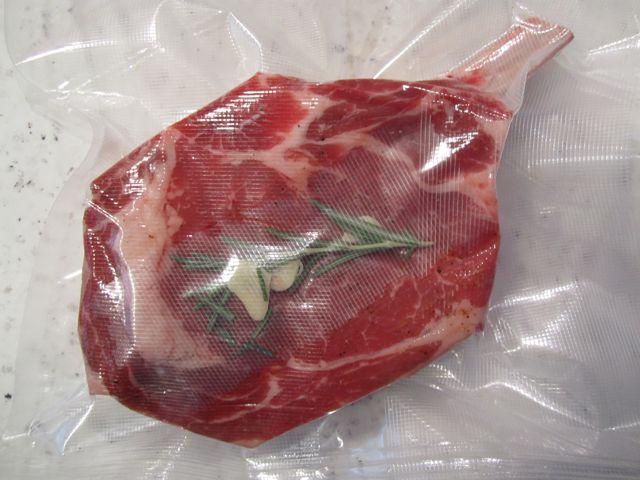
Combining Rib Eye Steaks Into a Roast...
in Cooking
Posted
Me too!